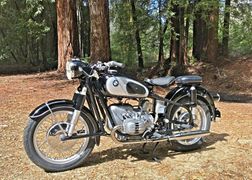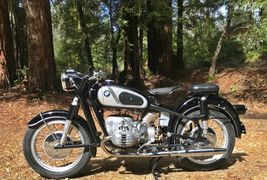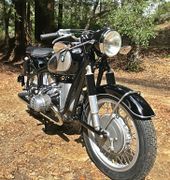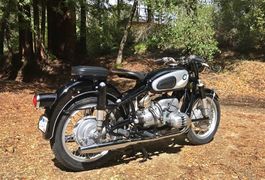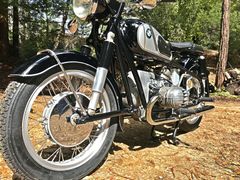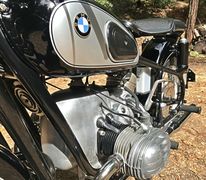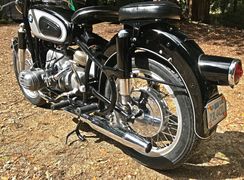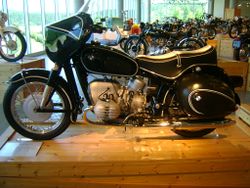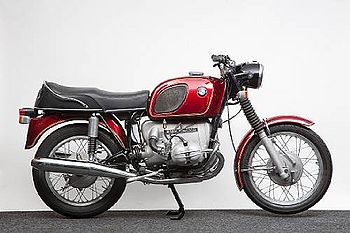Difference between revisions of "BMW R50"
(expanding) |
(template fixes) |
||
| (9 intermediate revisions by 3 users not shown) | |||
| Line 1: | Line 1: | ||
{{DISPLAYTITLE:{{PAGENAME}}: history, specs, pictures}} | |||
{{Motorcycle | |||
|name = BMW R50 | |||
|photo = Bmw-r50-1955-1960-0.jpg | |||
{{ | |||
{{ | |||
|name = | |||
| | |||
|aka = R50 2, R50US, R50 5, R50 OS, R 50 | |aka = R50 2, R50US, R50 5, R50 OS, R 50 | ||
|manufacturer = | |manufacturer = BMW | ||
|parent_company = | |parent_company = | ||
|production = 1955 - 1969 | |production = 1955 - 1969 | ||
| Line 47: | Line 10: | ||
|predecessor = | |predecessor = | ||
|successor = | |successor = | ||
|class = | |class = Classic | ||
|engine = two cylinder boxer, four-stroke | |engine = two cylinder boxer, four-stroke | ||
|bore_stroke = 68.0mm x 68.0mm | |bore_stroke = 68.0mm x 68.0mm | ||
| Line 56: | Line 19: | ||
|ignition = magneto | |ignition = magneto | ||
|spark_plug = | |spark_plug = | ||
|battery = | |battery = | ||
|transmission = Gear box: 4-speed <br> | |transmission = Gear box: 4-speed <br> | ||
Final Drive: [[shaft]] drive (cardan) <br> | Final Drive: [[shaft]] drive (cardan) <br> | ||
| Line 77: | Line 40: | ||
|fuel_capacity = 4.49 Gallon (17.00 Liters) | |fuel_capacity = 4.49 Gallon (17.00 Liters) | ||
|oil_capacity = | |oil_capacity = | ||
|fuel_consumption = 5.10 | |fuel_consumption = 5.10 liters/100 km (19.6 km/l or 46.12 mpg) | ||
|turning_radius = | |turning_radius = | ||
|related = | |related = | ||
| Line 95: | Line 58: | ||
==1955 - 1960 BMW R 50== | ==1955 - 1960 BMW R 50== | ||
The 1955 BMW R 55 has, at its heart, an air-cooled, four-stroke, 494cc, boxer twin cylinder powerplant mated to a four-speed manual transmission, and can produce a claimed 26 horsepower at 5800 rpm. Standard fittings for this machine include a telescopic front fork, a rear suspension composed of a long swinging arm with suspension units and oil pressure shock absorbers, a drum braking system, a single seat, laced wheels, a large headlamp, full fenders, and mid-mounted foot pegs. | The 1955 BMW R 55 has, at its heart, an air-cooled, four-stroke, 494cc, boxer twin cylinder powerplant mated to a four-speed manual transmission, and can produce a claimed 26 horsepower at 5800 rpm. Standard fittings for this machine include a telescopic front fork, a rear suspension composed of a long swinging arm with suspension units and oil pressure shock absorbers, a drum braking system, a single seat, laced wheels, a large headlamp, full fenders, and mid-mounted foot pegs. | ||
The '''R50''' and '''R50/2''' are 500 [[cc]] [[boxer twin]] [[BMW]] [[motorcycles]] that were manufactured from 1956 to 1969 in Munich, Germany, by the Bayerische Motoren Werke (BMW Aktiengesellschaft). | |||
==Engineering Excellence== | |||
In 1955 BMW created its '''R50''', [[BMW R60|R60]], and [[BMW R69|R69]] models. The new models had a similar [[engine]] and the same shaft-drive as earlier models, but were fitted with modern swinging fork rear suspension for the first time. But it abandoned modern telescopic forks at the front in favor of the swinging or "[[Earles Fork]]" system. The chassis was painted in BMW's signature black scheme set off by white pin striping. The models had plenty of power to pull an optional BMW Spezial [[Steib sidecar]]. An interesting side note is that the [[BMW R25]] was exactly one half of the engine in the BMW R50, using the same cylinder head etc. The BMW R50 produced 26 [[horsepower]]. | |||
==The Top of the World== | |||
The R50 was updated as the R50/2 in 1960 and joined by the sporting [[BMW R69S|R69S]]. BMW has always built expensive motorcycles, but you got what you paid for. They have gained an enviable reputation for long-lasting reliability -even the quality of the black paint is wellknown! BMW set the standard for its day, and continues to build some of the most famous motorcycles in the world into the Nineties. | |||
==1955== | |||
<gallery mode='packed-hover'> | |||
File:1955-bmw-r50-0.jpg|1955 BMW R50 | |||
File:1955-bmw-r50-1.jpg|1955 BMW R50 | |||
File:1955-bmw-r50-2.jpg|1955 BMW R50 | |||
File:1955-bmw-r50-3.jpg|1955 BMW R50 | |||
File:1955-bmw-r50-4.jpg|1955 BMW R50 | |||
File:1955-bmw-r50-5.jpg|1955 BMW R50 | |||
File:1955-bmw-r50-6.jpg|1955 BMW R50 | |||
</gallery> | |||
==1957== | |||
[[Image:1957 BMW R50.jpg|left|thumb|1957 BMW R50]] | |||
{{clear}} | |||
This machine has period accessories, Wixom fairing and [[Enduro]] bags, both made in the USA. | |||
==1966== | |||
<gallery mode="slideshow"> | |||
Image:1966-BMW-R50-2-Black-8762-0.jpg|1966 BMW R50/2 in Black | |||
Image:1966-BMW-R50-2-Black-8762-1.jpg|1966 BMW R50/2 in Black | |||
Image:1966-BMW-R50-2-Black-8762-2.jpg|1966 BMW R50/2 in Black | |||
Image:1966-BMW-R50-2-Black-8762-3.jpg|1966 BMW R50/2 in Black | |||
Image:1966-BMW-R50-2-Black-8762-4.jpg|1966 BMW R50/2 in Black | |||
Image:1966-BMW-R50-2-Black-8762-5.jpg|1966 BMW R50/2 in Black | |||
</gallery> | |||
==R50/5== | |||
[[Image:R50-5.jpg|thumb|350px|BMW R50/5]] | |||
The long-awaited replacements for BMW's long-running Earles-forked flat twins finally arrived in 1969. As well as a telescopic, leading-axle front fork, the newcomers featured a lightweight, welded, duplex frame, innovations first seen on the Bavarian company's ISDT machines. The engine too had come in for revision, now employing a one-piece forged crankshaft and aluminum-alloy cylinder barrels while carrying its camshaft below the crank. Coil ignition and 12-volt electrics were other new departures for the Munich firm. The new '/5' models came in three engine capacities, the variation being achieved by different bore sizes in what were otherwise virtually identical machines. The R50/5 produced a claimed 32bhp, which was good enough for a top speed of 98mph. | |||
== Videos == | |||
{{#ev:youtube|https://www.youtube.com/watch?v=NdBptlmu7kA|600|center}} | |||
==In Media== | ==In Media== | ||
*[https://motopixel.org/pixel/katy-perry-the-one-that-got-away Katy Perry's music video for "The One That Got Away" used a BMW R50/2] | |||
*[https://motopixel.org/bikes/bmw-r-502 BMW R50/2 in media] | |||
* [https://motopixel.org/pixel/ystein-og-meg#bmw-r50 Øystein og meg] | * [https://motopixel.org/pixel/ystein-og-meg#bmw-r50 Øystein og meg] | ||
* [https://motopixel.org/pixel/la-peau-de-torpedo#bmw-r50 La peau de torpédo] | * [https://motopixel.org/pixel/la-peau-de-torpedo#bmw-r50 La peau de torpédo] | ||
| Line 171: | Line 178: | ||
* [https://motopixel.org/pixel/on-her-majestys-secret-service#bmw-r50 On Her Majesty's Secret Service] | * [https://motopixel.org/pixel/on-her-majestys-secret-service#bmw-r50 On Her Majesty's Secret Service] | ||
{{BMW}} | |||
[[Category:BMW motorcycles|R50]] | |||
[[Category:BMW R series]] | |||
[[Category:Classic motorcycles]] | [[Category:Classic motorcycles]] | ||
[[Category: | [[Category:1950s motorcycles]] | ||
[[Category:1960s motorcycles]] | [[Category:1960s motorcycles]] | ||
Latest revision as of 20:11, 23 November 2019
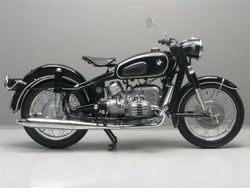 |
|
| BMW R50 | |
| Manufacturer | |
|---|---|
| Also called | R50 2, R50US, R50 5, R50 OS, R 50 |
| Production | 1955 - 1969 |
| Class | Classic |
| Engine | two cylinder boxer, four-stroke |
| Bore / Stroke | 68.0mm x 68.0mm |
| Compression ratio | 6.8:1 |
| Top Speed | 87 mph (140 km/h) |
| Horsepower | 25.48 HP (19.0 KW) @ 5800RPM |
| Torque | 28.77 ft/lbs (39.0 Nm) @ 5000RPM |
| Ignition | magneto |
| Transmission | Gear box: 4-speed Final Drive: shaft drive (cardan) |
| Suspension | Front: cartridge Rear: twin shock-swingarm |
| Brakes | Front: expanding brake (drum brake) Rear: expanding brake (drum brake) |
| Front Tire | 3.50-18 |
| Rear Tire | 3.50-18 |
| Wheelbase | 55.71 inches (1415 mm) |
| Length | 83.66 inches (2125 mm) |
| Width | 25.98 inches (660 mm) |
| Height | 38.58 inches (980 mm) |
| Seat Height | 33.46 inches (850 mm) |
| Weight | 195.0 kg (wet) |
| Fuel Capacity | 4.49 Gallon (17.00 Liters) |
| Fuel Consumption | 5.10 liters/100 km (19.6 km/l or 46.12 mpg) |
| Manuals | Service Manual |
The BMW R50 2 was a two cylinder boxer, four-stroke Classic motorcycle produced by BMW between 1955 and 1969. It could reach a top speed of 87 mph (140 km/h). Max torque was 28.77 ft/lbs (39.0 Nm) @ 5000 RPM. Claimed horsepower was 25.48 HP (19.0 KW) @ 5800 RPM.
Engine[edit | edit source]
The engine was a air cooled two cylinder boxer, four-stroke. A 68.0mm bore x 68.0mm stroke result in a displacement of just 494.0 cubic centimeters. Fuel was supplied via a overhead valves (ohv).
Drive[edit | edit source]
The bike has a 4-speed transmission. Power was moderated via the dry-single plate-cable operated.
Chassis[edit | edit source]
It came with a 3.50-18 front tire and a 3.50-18 rear tire. Stopping was achieved via expanding brake (drum brake) in the front and a expanding brake (drum brake) in the rear. The front suspension was a cartridge while the rear was equipped with a twin shock-swingarm. The R50 2 was fitted with a 4.49 Gallon (17.00 Liters) fuel tank. The wheelbase was 55.71 inches (1415 mm) long.
1955 - 1960 BMW R 50[edit | edit source]
The 1955 BMW R 55 has, at its heart, an air-cooled, four-stroke, 494cc, boxer twin cylinder powerplant mated to a four-speed manual transmission, and can produce a claimed 26 horsepower at 5800 rpm. Standard fittings for this machine include a telescopic front fork, a rear suspension composed of a long swinging arm with suspension units and oil pressure shock absorbers, a drum braking system, a single seat, laced wheels, a large headlamp, full fenders, and mid-mounted foot pegs.
The R50 and R50/2 are 500 cc boxer twin BMW motorcycles that were manufactured from 1956 to 1969 in Munich, Germany, by the Bayerische Motoren Werke (BMW Aktiengesellschaft).
Engineering Excellence[edit | edit source]
In 1955 BMW created its R50, R60, and R69 models. The new models had a similar engine and the same shaft-drive as earlier models, but were fitted with modern swinging fork rear suspension for the first time. But it abandoned modern telescopic forks at the front in favor of the swinging or "Earles Fork" system. The chassis was painted in BMW's signature black scheme set off by white pin striping. The models had plenty of power to pull an optional BMW Spezial Steib sidecar. An interesting side note is that the BMW R25 was exactly one half of the engine in the BMW R50, using the same cylinder head etc. The BMW R50 produced 26 horsepower.
The Top of the World[edit | edit source]
The R50 was updated as the R50/2 in 1960 and joined by the sporting R69S. BMW has always built expensive motorcycles, but you got what you paid for. They have gained an enviable reputation for long-lasting reliability -even the quality of the black paint is wellknown! BMW set the standard for its day, and continues to build some of the most famous motorcycles in the world into the Nineties.
1955[edit | edit source]
1957[edit | edit source]
This machine has period accessories, Wixom fairing and Enduro bags, both made in the USA.
1966[edit | edit source]
R50/5[edit | edit source]
The long-awaited replacements for BMW's long-running Earles-forked flat twins finally arrived in 1969. As well as a telescopic, leading-axle front fork, the newcomers featured a lightweight, welded, duplex frame, innovations first seen on the Bavarian company's ISDT machines. The engine too had come in for revision, now employing a one-piece forged crankshaft and aluminum-alloy cylinder barrels while carrying its camshaft below the crank. Coil ignition and 12-volt electrics were other new departures for the Munich firm. The new '/5' models came in three engine capacities, the variation being achieved by different bore sizes in what were otherwise virtually identical machines. The R50/5 produced a claimed 32bhp, which was good enough for a top speed of 98mph.
Videos[edit | edit source]
In Media[edit | edit source]
- Katy Perry's music video for "The One That Got Away" used a BMW R50/2
- BMW R50/2 in media
- Øystein og meg
- La peau de torpédo
- The Producers
- Filmavisen
- Max et les ferrailleurs
- À toi de faire... mignonne
- American Flyers
- Deuce of Spades
- MythBusters
- Die Halbzarte
- Los canallas
- Olsen-banden
- La nuit américaine
- Breathless
- Elle cause plus, elle flingue
- Le triporteur
- Hibernatus
- The Worlds Greatest Rally Cars
- Stahlnetz - E 605
- Garde à vue
- Cent briques et des tuiles
- Il diavolo a sette facce
- Tante Trude aus Buxtehude
- The Dirt Bike Kid
- The Black Pimpernel
- J'ai tout donné
- Aux frontières du possible
- Le glaive et la balance
- Look at Life: Pushing the Bike
- J'ai peur d'oublier
- Bitka na Neretvi
- Folle à tuer
- Tout va bien
- Mein Name ist Eugen
- Piloto de pruebas
- Der Experte
- Konrad Adenauer Stunden der Entscheidung
- Arrriva Dorellik
- C'est facile et ça peut rapporter... 20 ans
- Das sündige Bett
- Les vacances de l'inspecteur Tahar
- Gloriana: How Far Do You Wanna Go?
- Les Lyonnais
- Pan Am
- Les saintes chéries
- La polizia ordina: sparate a vista
- Malevil
- The Reader
- Le couteau dans la plaie
- Dans l'eau... qui fait des bulles!...
- Arrivano Joe e Margherito
- Pour 100 briques t'as plus rien...
- Ettore lo fusto
- Les enquêtes du commissaire Maigret
- Sur un arbre perché
- Le facteur de Saint-Tropez
- Flic ou voyou
- La batalla de Chile: La lucha de un pueblo sin armas - 3
- La batalla de Chile: La lucha de un pueblo sin armas - 1
- Tilbake til 60-tallet
- Association de malfaiteurs
- Sound of Näverlur
- Olsen-banden og Dynamitt-Harry
- Sans sommation
- The Baader Meinhof Complex
- Le guignolo
- Zycie na goraco
- Sjecas li se Dolly Bell
- On Her Majesty's Secret Service
| |||||||||||||||||
